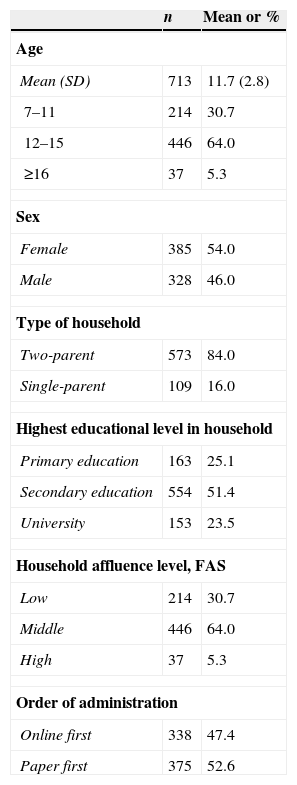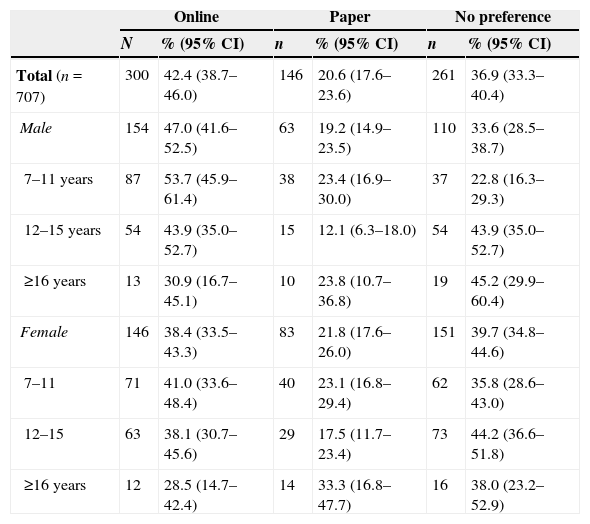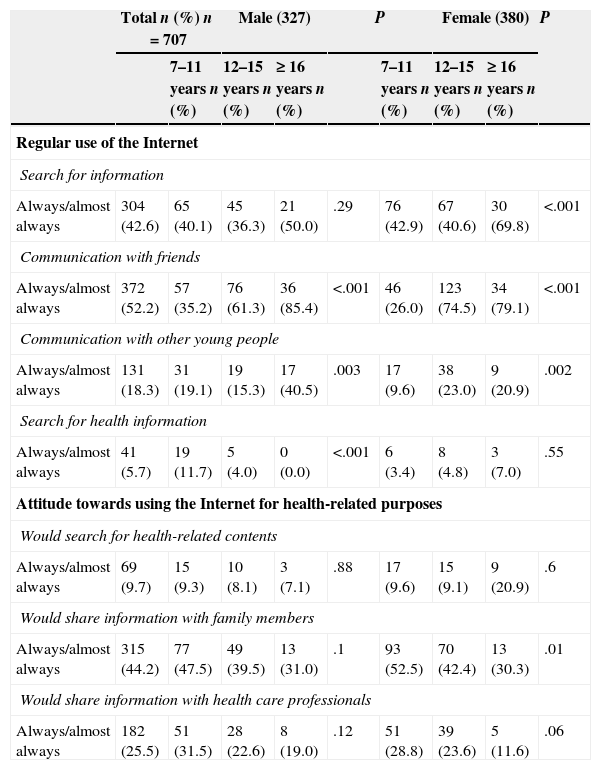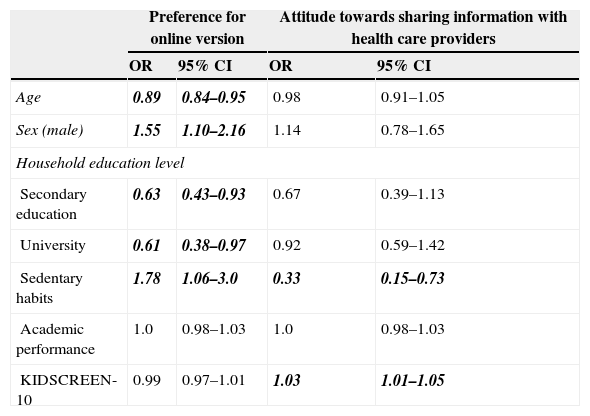To describe the preferences to complete questionnaires via the Internet by schoolchildren, as well as to analyse the attitude towards the use of Internet to communicate with health professionals.
MethodsCross-sectional study of a school population in Palafolls (Barcelona, n=923) was conducted in October and November 2013. Participants completed both Internet and paper versions on a single school day, in random order, and with at least an interval of 2h. Preferences to answer Internet vs. paper version were recorded, along with the willingness to share information with health professionals. Percentages of use preferences and attitudes were estimated, and logistic regression models were fitted to analyse the association with the preferences and willingness to share information with health professionals.
ResultsParticipation rates were 77% (n=715), of whom 42.4% (38.7–46.0) preferred the Internet version, and 20.6% (17.6–23.6) the paper version. Older children (odds ratio [OR]=0.89, 0.84–0.95 for age), and those from families with secondary school (OR=0.63, 0.43–0.93), and university degree (OR=0.61, 0.38–0.97) were less likely to prefer the Internet version, while boys (OR=1.55, 1.10–2.16) and those children reporting sedentary habits (OR=1.78, 1.06–3.0) were more likely to prefer the Internet version. Those scoring higher quality of life (OR=1.03, 1.01–1.05) and not reporting sedentary habits (OR=0.33, 0.15–0.73) were factors associated with a positive attitude to share information with health professionals.
ConclusionsYounger children prefer to use the Internet. Although Internet use is very widespread, it is less used to communicate with health professionals.
Describir las preferencias para responder cuestionarios vía web en población infantil escolarizada; y analizar la actitud sobre el uso de Internet para comunicarse con los profesionales de salud.
MétodosEstudio transversal de la población escolar de Palafolls (Barcelona, n=923) en octubre y noviembre de 2013. Los participantes contestaron las versiones web y en papel en un día de clase, en orden aleatorizado y con un intervalo mínimo de 2horas. Se recogieron las preferencias por una u otra versión, y la intención de compartir información con los profesionales de salud. Se calcularon porcentajes de uso y actitudes, y se ajustaron modelos de regresión logística.
ResultadosParticipación de 77% (n=715). El 42,4% (38,7–46,0) declaró preferir la versión web y el 20,6% (17,6–23,6) prefirió la versión papel. Los de mayor edad (odds ratio [OR]=0,89; 0,84–0,95 para la edad), y los de familias con nivel de estudios secundarios (OR=0,63; 0,43–0,93) o universitarios (OR=0,61; 0,38–0,97) presentaron menor probabilidad de preferir la versión web. Los varones (OR=1,55; 1,10–2,16), y los que declararon hábitos sedentarios (OR=1,78; 1,06–3,0) presentaron mayor probabilidad de preferir la versión web. La puntuación más elevada (mejor) en calidad de vida (OR=1,03; 1,01–1,05) y no declarar hábitos sedentarios (OR=0,33; 0,15–0,73) se asoció con la actitud positiva para compartir información con los profesionales de salud.
ConclusionesLos niños más jóvenes declaran preferir la versión web. Aunque el uso de Internet es muy generalizado, está poco extendido para comunicarse con los profesionales sanitarios.
The use of the Internet and information and communication technologies (ICTs) to collect data from health surveys in adolescents has grown exponentially in past years.1 More recently, these technologies have been used to carry out health care and promotion interventions, trying to adapt said interventions to the needs of individuals and families.2 Most of the studies published on the subject focus on adolescents and young adults and implement interventions that address habits such as smoking,3 mental health4 or sexual health.5,6
A series of factors ought to be taken into account in relation to the use of the Internet in the paediatric age group, such as the variety and quality of the available information and its potential limitations and adverse effects.7
The evidence on using the Internet for both the purposes of gathering information and carrying out health care interventions in children and adolescents is scarce in our field. Studies on this subject have usually focused on analysing the use of different mass media.8
It may be that, despite the widespread use of social networks (facebook, twitter, etc.) and their early introduction to the paediatric population, ICTs are only used for entertainment and leisure and hardly ever for health-related purposes. Given their potential usefulness, not only for data collection but also for the implementation of public health interventions in children, it is important that we learn the attitudes and willingness of this age group to use ICTs for this purpose. The development of the digital version of the Euroqol 5D-Youth (EQ-5D-Y) and KIDSCREEN health questionnaires for children and adolescents has given us the opportunity to analyse the use of technology in the paediatric population.
The main aim of our study was to describe the preferences of the population of children and adolescents attending school for completing the online or paper versions of health questionnaires. Our secondary objective was to analyse the use of the Internet to interact with peers and as a source of general and health-related information, and to analyse the factors associated with a positive attitude towards online communication with health care providers.
MethodsWe conducted a cross-sectional study of the student population of the three public schools of Palafolls (province of Barcelona) from the 3rd year of primary education to the 2nd year of Bachillerato, the final year of high school (n=923). Between October and November 2013, online and paper questionnaires were administered to all students whose parents signed the informed consent and filled out a brief questionnaire of family characteristics and agreed to participate in the study. All students completed the online and paper versions on a school day and in random order. The online versions of the questionnaires were administered in the machines available at the computer room of each school. The time elapsed between the administration of the two versions comprised at least 1h of regular schoolwork and another hour of recreational activities.
We adhered to both European and Spanish regulations and requirements concerning confidentiality and data management, as well as to ethical and legal mandates. The study protocol was approved by the ethics and clinical research committee of the Hospital del Mar, Barcelona.
Variables under studyWe documented student preferences for completing either version (preference for online version, preference for paper version, or no preference). We obtained information on the frequency of Internet use to search for general information, to get in touch with friends, to communicate with other young people, and for health-related purposes. We also collected data on the willingness to use the Internet to obtain information on health-related issues and the attitude towards using it to share information with family members and health care providers. We adapted the questionnaire from a previous study of similar characteristics.9 The answers to all items were formulated as a Likert scale with five levels referring to frequency (from never to always), which were later dichotomised into always/almost always and sometimes/rarely/never for the analyses.
We also documented age, sex, school year, household affluence level10; household education level, presence of chronic diseases (yes/no using a list of 16 chronic diseases that are frequent in this age group; data for the last two variables were collected from the questionnaire given to parents), and health-related quality of life (HRQoL, KIDSCREEN-52 questionnaire11). Sedentary habits were documented following the recommendations of previous international studies12 and classified into either 2 or more hours or less than 2h of screen time a day. We analysed academic performance by means of the subdomain of the Child Health and Illness Profile Adolescent Edition (CHIP-AE)13 that assesses how children perceive their own academic performance.
The full questionnaire is available upon request to the authors.
Statistical analysisWe calculated the percentages of Internet use and the attitudes associated to it by age group (7–11, 12–5 and ≥16 years), sex, and sociodemographic factors (highest level of education in the household and type of household), HRQoL, sedentary habits and reported health problems (presence or absence of chronic diseases). We calculated the 95% confidence intervals (95% CI) of the proportions in relation to the preference for completing the online or paper-based versions. We fitted logistic regression models to analyse the factors associated to the preferences for answering questionnaires online and the willingness to share health-related information with health professionals.
We performed the statistical analysis with the STATA software, version 11.2 (StataCorp LP, Texas, United States).
ResultsThe participation rate was 77% (n=715). Fifty-four percent of participants were female, the mean age was 11.7 years, 23% belonged to households with university-level educations, and 30% reported a low affluence level (Table 1).
Sample characteristics. Palafolls study (n=715).
| n | Mean or % | |
|---|---|---|
| Age | ||
| Mean (SD) | 713 | 11.7 (2.8) |
| 7–11 | 214 | 30.7 |
| 12–15 | 446 | 64.0 |
| ≥16 | 37 | 5.3 |
| Sex | ||
| Female | 385 | 54.0 |
| Male | 328 | 46.0 |
| Type of household | ||
| Two-parent | 573 | 84.0 |
| Single-parent | 109 | 16.0 |
| Highest educational level in household | ||
| Primary education | 163 | 25.1 |
| Secondary education | 554 | 51.4 |
| University | 153 | 23.5 |
| Household affluence level, FAS | ||
| Low | 214 | 30.7 |
| Middle | 446 | 64.0 |
| High | 37 | 5.3 |
| Order of administration | ||
| Online first | 338 | 47.4 |
| Paper first | 375 | 52.6 |
Missing data (n): age (2); sex (2); type of household (33); household affluence level (FAS, 18); level of education (65); order of administration (2).
FAS, Family Affluence Scale; SD, standard deviation.
Of all respondents, 42.4% (95% CI, 38.7–46.0) stated a preference for the online version, 36.9% (95% CI, 33.3–40.4) declared having no preference, and 20.6% (95% CI, 17.6–23.6) preferred the paper version (Table 2). The preference for completing the online version was more frequent among younger boys, while girls and older students of both sexes stated having no preference, although these differences were not statistically significant.
Preferences for using online and paper versions of health questionnaires.
| Online | Paper | No preference | ||||
|---|---|---|---|---|---|---|
| N | % (95% CI) | n | % (95% CI) | n | % (95% CI) | |
| Total (n=707) | 300 | 42.4 (38.7–46.0) | 146 | 20.6 (17.6–23.6) | 261 | 36.9 (33.3–40.4) |
| Male | 154 | 47.0 (41.6–52.5) | 63 | 19.2 (14.9–23.5) | 110 | 33.6 (28.5–38.7) |
| 7–11 years | 87 | 53.7 (45.9–61.4) | 38 | 23.4 (16.9–30.0) | 37 | 22.8 (16.3–29.3) |
| 12–15 years | 54 | 43.9 (35.0–52.7) | 15 | 12.1 (6.3–18.0) | 54 | 43.9 (35.0–52.7) |
| ≥16 years | 13 | 30.9 (16.7–45.1) | 10 | 23.8 (10.7–36.8) | 19 | 45.2 (29.9–60.4) |
| Female | 146 | 38.4 (33.5–43.3) | 83 | 21.8 (17.6–26.0) | 151 | 39.7 (34.8–44.6) |
| 7–11 | 71 | 41.0 (33.6–48.4) | 40 | 23.1 (16.8–29.4) | 62 | 35.8 (28.6–43.0) |
| 12–15 | 63 | 38.1 (30.7–45.6) | 29 | 17.5 (11.7–23.4) | 73 | 44.2 (36.6–51.8) |
| ≥16 years | 12 | 28.5 (14.7–42.4) | 14 | 33.3 (16.8–47.7) | 16 | 38.0 (23.2–52.9) |
Data are presented by sex and age group. 95% CI, 95% confidence interval. Missing data (n): age and sex (2); preference (8).
Older girls reported a more frequent use of the Internet to search for general information compared to younger girls (69.8% of girls 16 years of age or older and 40.6% of those 12–15 years; P<.001; Table 3). This difference was not statistically significant in boys. Older children of both sexes reported using the Internet to get in touch with friends and other young people (P<.001). The proportion that reported using the web for searching health information was 5.7%. We found statistically significant differences in the search for health information, with a higher proportion of younger boys searching compared to older males. We did not find this difference among females. We also observed a lower proportion of older children that stated an interest in sharing information with family members. A greater proportion of younger children of both sexes reported a willingness to share information with health care professionals compared to older children (31% of boys and 28% of girls 7–11 years of age), although these differences were not statistically significant.
Frequency of Internet use for social contents and for health information (proportion that use it for those purposes always/almost always and sometimes/rarely/never).
| Total n (%) n=707 | Male (327) | P | Female (380) | P | |||||
|---|---|---|---|---|---|---|---|---|---|
| 7–11 years n (%) | 12–15 years n (%) | ≥16 years n (%) | 7–11 years n (%) | 12–15 years n (%) | ≥16 years n (%) | ||||
| Regular use of the Internet | |||||||||
| Search for information | |||||||||
| Always/almost always | 304 (42.6) | 65 (40.1) | 45 (36.3) | 21 (50.0) | .29 | 76 (42.9) | 67 (40.6) | 30 (69.8) | <.001 |
| Communication with friends | |||||||||
| Always/almost always | 372 (52.2) | 57 (35.2) | 76 (61.3) | 36 (85.4) | <.001 | 46 (26.0) | 123 (74.5) | 34 (79.1) | <.001 |
| Communication with other young people | |||||||||
| Always/almost always | 131 (18.3) | 31 (19.1) | 19 (15.3) | 17 (40.5) | .003 | 17 (9.6) | 38 (23.0) | 9 (20.9) | .002 |
| Search for health information | |||||||||
| Always/almost always | 41 (5.7) | 19 (11.7) | 5 (4.0) | 0 (0.0) | <.001 | 6 (3.4) | 8 (4.8) | 3 (7.0) | .55 |
| Attitude towards using the Internet for health-related purposes | |||||||||
| Would search for health-related contents | |||||||||
| Always/almost always | 69 (9.7) | 15 (9.3) | 10 (8.1) | 3 (7.1) | .88 | 17 (9.6) | 15 (9.1) | 9 (20.9) | .6 |
| Would share information with family members | |||||||||
| Always/almost always | 315 (44.2) | 77 (47.5) | 49 (39.5) | 13 (31.0) | .1 | 93 (52.5) | 70 (42.4) | 13 (30.3) | .01 |
| Would share information with health care professionals | |||||||||
| Always/almost always | 182 (25.5) | 51 (31.5) | 28 (22.6) | 8 (19.0) | .12 | 51 (28.8) | 39 (23.6) | 5 (11.6) | .06 |
Older students (odds ratio [OR], 0.89; 95% IC, 0.84–0.95 for age), and students from households with the highest education level corresponding to secondary school (OR, 0.63; 95% IC, 0.43–0.93) or university (OR, 0.61; 95% IC, 0.38–0.97) were less likely to prefer the online version, while male students (OR, 1.55; 95% IC, 1.10–2.16) and students that reported sedentary habits (OR, 1.78; 95% IC, 1.06–3.0) were more likely to prefer the online version compared to the paper one (Table 4).
Multivariate models of factors associated with a preference for completing the online version and a positive attitude towards sharing information with health care providers (n=644).
| Preference for online version | Attitude towards sharing information with health care providers | |||
|---|---|---|---|---|
| OR | 95% CI | OR | 95% CI | |
| Age | 0.89 | 0.84–0.95 | 0.98 | 0.91–1.05 |
| Sex (male) | 1.55 | 1.10–2.16 | 1.14 | 0.78–1.65 |
| Household education level | ||||
| Secondary education | 0.63 | 0.43–0.93 | 0.67 | 0.39–1.13 |
| University | 0.61 | 0.38–0.97 | 0.92 | 0.59–1.42 |
| Sedentary habits | 1.78 | 1.06–3.0 | 0.33 | 0.15–0.73 |
| Academic performance | 1.0 | 0.98–1.03 | 1.0 | 0.98–1.03 |
| KIDSCREEN-10 | 0.99 | 0.97–1.01 | 1.03 | 1.01–1.05 |
Reference categories: female, university level of education. Missing data: level of education, n=65. Statistically significant coefficients are presented in bold and italics.
Children of both sexes that scored better in the KIDSCREEN-10 were more likely to report a positive attitude towards sharing information with health care professionals over the Internet (OR, 1.03; 1.01–1.05). Those that reported sedentary habits showed a less positive attitude towards sharing such information (OR, 0.33; 95% IC, 0.15–0.73 for sedentary habits; Table 4).
DiscussionThe results of our study show that younger children state a preference for using the Internet to complete questionnaires more frequently than adolescents. We observed a widespread use of the Internet as a means of social communication and activities, especially among adolescents. However, these population groups do not use this medium to search for health information, and generally show little inclination to use it to communicate with health care providers. The results of the study should be taken into account any time an ICT-based health intervention is going to be implemented in the paediatric population.
Younger boys expressed a preference for completing questionnaires online more frequently than other participants. This factor could be related to the increasingly widespread use of ICTs from earlier ages. Furthermore, its use could have a cohort effect, that is, future generations could initiate exposure to ICTs increasingly early, and this may facilitate the spread of these technologies.
The fact that children from households where the highest level of education was primary school expressed a greater predisposition to completing the questionnaire online was unexpected. However, the finding that students that reported more sedentary habits preferred online completion was consistent with our expectations. Children that are more sedentary spend more time using ICTs and thus are more inclined to use them. This is one of the factors to consider in the implementation of interventions that favour the use of ICTs, which encourages sedentary habits and as a result may promote an increase in childhood obesity and related problems.14,15 Our study did not find an association between sedentary behaviour and household education level, although these factors should be taken into account in future studies and when interventions are implemented.
On the other hand, while the results of the bivariate analysis show that younger children are more inclined to use the Internet for health-related purposes, these results were not confirmed by the multivariate analysis.
One of the most important barriers to the spread and use of the Internet for the administration of health questionnaires and communication with health services is the lack of Internet access and social inequalities in access. However, a recent study showed that the penetration of the Internet in the 14- to 19-year-old population in Spain is of 83.7%, although there is a gradient associated with social class.16 Meanwhile, data from the Instituto Nacional de Estadística (National Institute of Statistics) for 2013 showed that 68.9% of households and 91% of the individuals 10–15 years of age used the Internet.17 Finally, in the population of schoolchildren, computer rooms in Spanish primary and secondary schools provide Internet access to students.
The factors that influenced the willingness to use the Internet to communicate with health care professionals were a better self-perceived health-related quality of life and not reporting sedentary habits. Although we could not establish the directionality of the association because the study had a cross-sectional design, any intervention in this population should take this factor into account. The inverse care law could be at play,18,19 with individuals that take the most advantage of health promotion using this or other media being those that need it least, for instance those with a better self-perceived health and reporting better habits, so that implemented interventions may actually increase health inequalities.
A few previous studies have investigated strategies to increase exposure to Internet and to online contents concerned with health-promotion.20 It is also necessary that we take into account the potential dangers and adverse effects of ICTs in this age group. Cyberbullying seems to have increased along with Internet use. The literature has described its negative impact on mental health,21 isolation from family or sedentary behaviours as mentioned above. Thus, it is advisable that preventive strategies be implemented along with the planned intervention.
One of the limitations of this study is that the validity of the responses to the questionnaire has never been assessed. However, most of its items are based on a previous questionnaire that, while developed in a different context, has shown an acceptable feasibility and discriminatory power.9 Furthermore, the results of the study also supported the validity of the questionnaire. A second limitation is that it is difficult to generalise our results since this is one of the first studies that analyses preferences and attitudes on Internet use. More research is needed on different populations to strengthen our results on the use of ICTs. Nevertheless, the fact that we included all students in Palafolls, a population with broad variability in its sociodemographic characteristics and that there was a high level of participation reinforces the representativeness of the findings. Thirdly, we did not analyse the potential adverse effects of the use of the Internet and ICTs overall, which should be the subject of future research. Fourth of all, in this study the digital questionnaires were administered in the computers in the schools’ computer rooms, and we did not attempt administration through other devices such as tablets or smart phones that may be even more appealing to the population under study. This aspect should be analysed in future studies to compare these modes of completion and the preferences of the surveyed individuals. Lastly, our study did not include the preferences and attitudes of the parents, which may be exert a significant influence as a facilitating factor, especially when it comes to health-related use.
Future studies on the use of the Internet in children and adolescents should assess its potential usefulness in everyday clinical practise,22 health promotion23 and patient–doctor communication.24 ICTs can play an essential role in health care management and improvement, especially for patients with chronic diseases.25 Our study did not find differences in the search for health information in students reported by parents to have a chronic disease. This may be due to the fact that we studied a sample of healthy students. On the other hand, the clinical diagnoses determined by parental reporting of chronic conditions through the family questionnaire may not be consistently valid. Furthermore, if research confirms that the Internet can be used to improve doctor–patient communication in paediatrics and promote health knowledge and healthy habits, the Internet could become a basic tool in everyday paediatric clinical practise.
In short, the use of the Internet in the paediatric age group for data collection and health promotion is very promising. However, it must be taken into account that younger children seem more inclined to complete questionnaires online than older adolescents. Internet use for communication and social activities is quite widespread, both in males and females, but its use for searching health information and communicating with health providers is scarce.
FundingThe study was funded by the Ministerio de Sanidad (Ministry of Health), project coordinated by the Biomedical Research Centre Network [CIBER] Centre for Epidemiology and Public Health [CIBERESP], grant number PI12/01296).
Conflicts of interestThe authors have no conflicts of interest to declare.
The authors want to thank the students of Palafolls and their families for their participation, and the teaching staff of participating schools for their support. We thank Gerbert Olive for helping develop the online version of the questionnaires. This study is part of the doctoral dissertation of Marta Murillo in the Universitat Autònoma de Barcelona.
Please cite this article as: Rajmil L, Robles N, Murillo M, Rodríguez-Arjona D, Azuara M, Ballester A, et al. Preferencias en el formato de cuestionarios y en el uso de Internet en escolares. An Pediatr (Barc). 2015;83:26–32.







